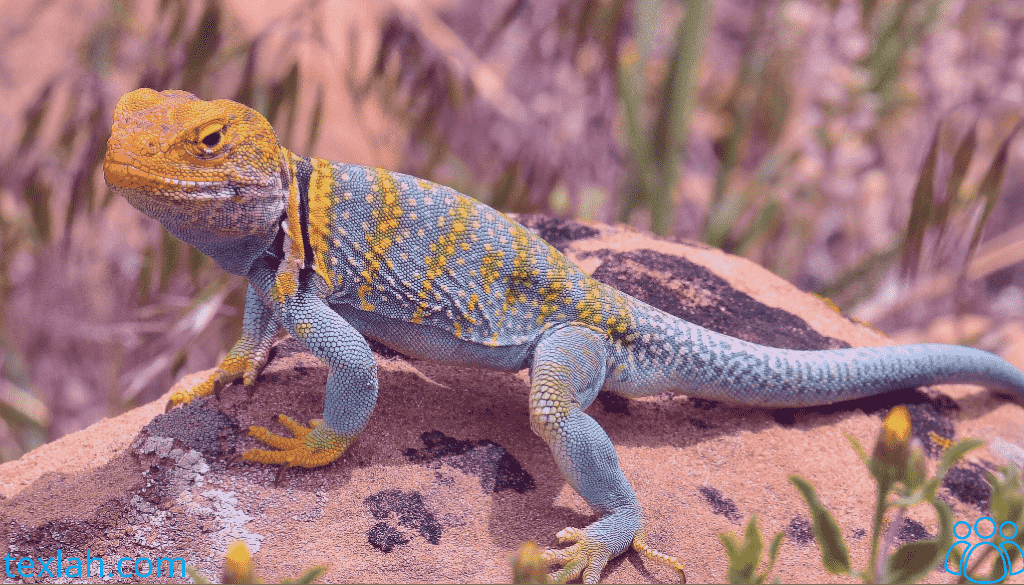The Collared Lizard, known for its vibrant colors and distinctive markings, inhabits arid regions of North America. With a diet comprising insects and small reptiles, they exhibit unique behaviors such as basking to regulate body temperature. Their striking appearance serves both communication and camouflage purposes. Understanding their habitat, reproduction, and role in the ecosystem unveils the fascinating life of Collared Lizards, contributing to the rich biodiversity of their native environments.
Embark on an enchanting journey into the vibrant world of Collared Lizards (Crotaphytus collaris), where unique behaviors and vivid hues paint a vivid picture of nature’s wonders. In this exploration, we delve deep into the intricate details of these captivating reptiles, uncovering their distinct features, habitats, and the vital role they play in maintaining ecological balance. Thus, explore the world of Collared Lizard.

Read More: Can Dogs Eat Cilantro?
Understanding Collared Lizard
Unraveling the tapestry of the charismatic Collared Lizard (Crotaphytus collaris) involves exploring their vibrant and captivating appearance. From vivid oranges and yellows to subtle greens and blues, these lizards boast a striking array of colors. The collar-like markings around their necks serve both aesthetic and functional purposes, potentially aiding in communication and territorial displays. With a moderately sized physique ranging from 8 to 15 inches, Collared Lizards are well-adapted to rocky habitats in arid landscapes, showcasing agile climbing and running abilities essential for survival. Territorial displays, basking behavior for thermoregulation, and molting further contribute to a comprehensive understanding of these reptiles, transcending their visual allure to delve into evolutionary adaptations and ecological roles.
Habitat and Range
Collared Lizards, belonging to the Crotaphytidae family, thrive in the arid regions of North America, spanning from Mexico to the southwestern United States. Their strong affinity for rocky terrains, filled crevices and boulders, aligns their agile climbing and running abilities, emphasizing adaptability. The arid environment reflects their evolutionary adaptation to sunlight-abundant regions. Understanding their habitat and range is crucial for appreciating the ecological niches they occupy and the delicate balance they maintain.
Distinctive Features: Collared Lizard
The Collared Lizard boasts distinctive features that make it a standout reptile in its native habitats. Known for its vibrant coloration and robust size, this lizard exhibits a striking blue or green hue on its body, often complemented by patterns and markings that contribute to its unique appearance. One of its most noteworthy features is the collar-like band around its neck, which varies in color and intensity among different species. This distinct marking not only lends the lizard its name but also serves various purposes, from communication to thermoregulation. Understanding these distinctive features sheds light on the fascinating adaptations that contribute to the Collared Lizard’s success in its arid environments.
- Colorful Collars: The iconic collar-like markings add aesthetic charm while serving functional roles in communication and territorial displays. Ranging from vivid oranges to subtle blues, these colors distinguish different species and contribute to survival.
- Impressive Size: With a moderately sized physique, Collared Lizards efficiently navigate rocky landscapes, showcasing adaptability and agility. Their size is integral to survival strategies, aiding in hunting and evading predators.
- Agile Movement: Renowned for agility, Collared Lizards exhibit skilled climbing and running abilities, essential for navigating rocky terrains. Their precise movements showcase evolutionary adaptations for thriving in challenging environments.
Behavioral Insights
The behavior of the Collared Lizard is as captivating as its appearance. These reptiles are known for their active and alert nature, often seen basking in the sun to regulate their body temperature. Their agility and quick movements make them adept hunters, preying on insects and other small creatures. Additionally, Collared Lizards are territorial and exhibit intriguing social behaviors, interactions ranging from courtship displays to territorial disputes. Studying these behavioral insights provides a deeper appreciation for the role of behavior in the survival and adaptation of the Collared Lizard in its diverse habitats.
- Territorial Displays: Captivating territorial displays, especially during the breeding season, offer insights into complex social structures. Head-bobbing, push-up displays, and color changes manifest their dynamic interactions in rocky habitats.
- Dietary Habits: Integral to ecosystems, Collared Lizards display diverse dietary habits, including insects and small animals. Hunting techniques such as stalking contribute to ecological balance, highlighting their role as consumers and contributors.
Conservation Status and Threats: Collared Lizard
The conservation status of the Collared Lizard is relatively stable, most species not currently listed as endangered. However, localized threats exist, primarily linked to habitat destruction due to human activities and urbanization. Conservation efforts focus on preserving their natural habitats, implementing sustainable land use practices, and raising awareness about the importance of maintaining biodiversity. Additionally, addressing climate change impacts on their ecosystems remains crucial for the long-term conservation of these distinctive reptiles. Understanding the conservation status and potential threats helps guide efforts to ensure the continued well-being of Collared Lizard populations in the wild.
Conclusion: Collared Lizard
In conclusion, the Collared Lizard stands as a fascinating reptilian species known for its distinctive features and vibrant coloration. From its unique behavior to its role in maintaining ecosystem balance, these lizards contribute to the biodiversity of their habitats. While conservation efforts are underway to address localized threats, continued research and awareness are essential for safeguarding the Collared Lizard’s future. Appreciating their significance in the natural world encourages a collective commitment to preserving these captivating reptiles and the ecosystems they inhabit.
Discover in-depth and reliable information on Texlah, your go-to platform for insightful content.
